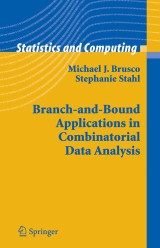Details

Branch-and-Bound Applications in Combinatorial Data Analysis
Statistics and Computing
|
CHF 130.00 |
|
| Verlag: | Springer |
| Format: | |
| Veröffentl.: | 30.11.2005 |
| ISBN/EAN: | 9780387288109 |
| Sprache: | englisch |
| Anzahl Seiten: | 222 |
Dieses eBook enthält ein Wasserzeichen.
Beschreibungen
This monograph focuses on the application of the solution strategy known as branch-and-bound to problems of combinatorial data analysis. Combinatorial data analysis problems typically require either the sel- tion of a subset of objects from a larger (master) set, the grouping of a collection of objects into mutually exclusive and exhaustive subsets, or the sequencing of objects. To obtain verifiably optimal solutions for this class of problems, we must evaluate (either explicitly or implicitly) all feasible solutions. Unfortunately, the number of feasible solutions for problems of combinatorial data analysis grows exponentially with pr- lem size. For this reason, the explicit enumeration and evaluation of all solutions is computationally infeasible for all but the smallest problems. The branch-and-bound solution method is one type of partial enume- tion solution strategy that enables some combinatorial data analysis pr- lems to be solved optimally without explicitly enumerating all feasible solutions. To understand the operation of a branch-and-bound algorithm, we d- tinguish complete solutions from partial solutions. A complete solution is one for which a feasible solution to the optimization problem has been produced (e. g. , all objects are assigned to a group, or all objects are - signed a sequence position). A partial solution is an incomplete solution (e. g. , some objects are not assigned to a group, or some objects are not assigned a sequence position).
Cluster Analysis—Partitioning.- An Introduction to Branch-and-Bound Methods for Partitioning.- Minimum-Diameter Partitioning.- Minimum Within-Cluster Sums of Dissimilarities Partitioning.- Minimum Within-Cluster Sums of Squares Partitioning.- Multiobjective Partitioning.- Seriation.- to the Branch-and-Bound Paradigm for Seriation.- Seriation—Maximization of a Dominance Index.- Seriation—Maximization of Gradient Indices.- Seriation—Unidimensional Scaling.- Seriation—Multiobjective Seriation.- Variable Selection.- to Branch-and-Bound Methods for Variable Selection.- Variable Selection for Cluster Analysis.- Variable Selection for Regression Analysis.
<P>There are a variety of combinatorial optimization problems that are relevant to the examination of statistical data. Combinatorial problems arise in the clustering of a collection of objects, the seriation (sequencing or ordering) of objects, and the selection of variables for subsequent multivariate statistical analysis such as regression. The options for choosing a solution strategy in combinatorial data analysis can be overwhelming. Because some problems are too large or intractable for an optimal solution strategy, many researchers develop an over-reliance on heuristic methods to solve all combinatorial problems. However, with increasingly accessible computer power and ever-improving methodologies, optimal solution strategies have gained popularity for their ability to reduce unnecessary uncertainty. In this monograph, optimality is attained for nontrivially sized problems via the branch-and-bound paradigm.</P>
<P>For many combinatorial problems, branch-and-bound approaches have been proposed and/or developed. However, until now, there has not been a single resource in statistical data analysis to summarize and illustrate available methods for applying the branch-and-bound process. This monograph provides clear explanatory text, illustrative mathematics and algorithms, demonstrations of the iterative process, psuedocode, and well-developed examples for applications of the branch-and-bound paradigm to important problems in combinatorial data analysis. Supplementary material, such as computer programs, are provided on the world wide web.</P>
<P>Dr. Brusco is a Professor of Marketing and Operations Research at Florida State University, an editorial board member for the Journal of Classification, and a member of the Board of Directors for the Classification Society of North America. Stephanie Stahl is an author and researcher with years of experience in writing, editing, and quantitative psychology research.</P>
<P>For many combinatorial problems, branch-and-bound approaches have been proposed and/or developed. However, until now, there has not been a single resource in statistical data analysis to summarize and illustrate available methods for applying the branch-and-bound process. This monograph provides clear explanatory text, illustrative mathematics and algorithms, demonstrations of the iterative process, psuedocode, and well-developed examples for applications of the branch-and-bound paradigm to important problems in combinatorial data analysis. Supplementary material, such as computer programs, are provided on the world wide web.</P>
<P>Dr. Brusco is a Professor of Marketing and Operations Research at Florida State University, an editorial board member for the Journal of Classification, and a member of the Board of Directors for the Classification Society of North America. Stephanie Stahl is an author and researcher with years of experience in writing, editing, and quantitative psychology research.</P>
Provides explanatory text, illustrative mathematics and algorithms, demonstrations of the iterative process, pseudocode, and well-developed examples for (familiar as well as novel) applications of the branch-and-bound paradigm to relevant problems in combinatorial data analysis
<P>This book provides explanatory text, illustrative mathematics and algorithms, demonstrations of the iterative process, pseudocode, and well-developed examples for (familiar as well as novel) applications of the branch-and-bound paradigm to relevant problems in combinatorial data analysis.</P>
Diese Produkte könnten Sie auch interessieren:

Linear and Integer Programming vs Linear Integration and Counting

von: Jean-Bernard Lasserre

CHF 118.00

Reactive Search and Intelligent Optimization

von: Roberto Battiti, Mauro Brunato, Franco Mascia

CHF 118.00














